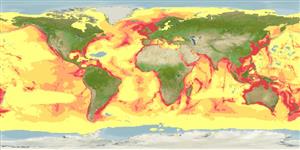Mammalia |
Cetartiodactyla |
Delphinidae
Environment: milieu / climate zone / Mức độ sâu / distribution range
Sinh thái học
Tầng nổi; Ở đại duơng, biển (Tài liệu tham khảo 75906); Mức độ sâu 0 - 1316 m (Tài liệu tham khảo 116169). Tropical; 90°N - 90°S, 180°W - 180°E
Atlantic Ocean, Indo-Pacific and Mediterranean and Black Sea. Tropical to temperate.
Length at first maturity / Bộ gần gũi / Weight / Age
Chín muồi sinh dục: Lm ?, range 240 - 260 cm Max length : 380 cm TL con đực/không giới tính; (Tài liệu tham khảo 1394); Khối lượng cực đại được công bố: 650.0 kg (Tài liệu tham khảo 1394)
Short description
Hình thái học
This coastal subspecies (Tursiops truncatus geyphyreus) can be distinguished from the nominate offshore subspecies (Tursiops truncatus truncatus) by the following diagnosable cranial features: W-shaped border of the antorbital notch (vs. U-shaped); barely or not visible interparietal bone (vs. clearly visible); cranial vertex from the posterior end of nasals to the nuchal crest is short and rectangular (vs. long and squared); left nasal bone noticeably smaller and more compressed antero-posteriorly than the right (vs. nearly symmetrical); Falciform lateral margin of the ascending process of right premaxilla (vs. straight or slightly concave); lateral margin of the ascending process of the maxillae over the preorbital process is deflected dorsally (vs. flat) (Ref. 128824).
Preyed upon by great white sharks (Ref. 32140). Dolphins are directly caught for use as shark-bait in Sta. Ana and Aparri, Philippines (Ref. 77119). Found primarily in coastal and inshore regions of tropical and temperate waters of the world (Ref. 936) and deeper channels between islands (Ref. 122680). Also inhabits pelagic waters, such as those in the eastern tropical Pacific (Ref. 936). In herds of less than 20 individuals (Ref. 801). Feeds either cooperatively or in solitary. They can obtain prey via 'fish whacking' and steering fish onto mudflats (Ref. 122680). Feeds on fish (Refs. 801, 936) crustaceans, and cephalopods (Ref. 801).
Life cycle and mating behavior
Chín muồi sinh dục | Sự tái sinh sản | Đẻ trứng | Eggs | Sự sinh sản | Larvae
Tan, J.M.L. 1995 A Field Guide to the Whales and Dolphins in the Philippines. Makati City: Bookmark. 125 p. (Tài liệu tham khảo 936)
IUCN Red List Status
(Tài liệu tham khảo 130435: Version 2025-1)
CITES status (Tài liệu tham khảo 108899)
CMS (Tài liệu tham khảo 116361)
Threat to humans
Human uses
Các nghề cá: Tính thương mại; mồi: usually
FAO - Các nghề cá: landings, species profile | FishSource | Biển chung quanh ta
Các công cụ
Thêm thông tin
PhysiologyThành phần ô-xy
Human RelatedStamps, coins, misc.
Các nguồn internet
Estimates based on models
Preferred temperature
(Ref.
115969): 6.4 - 28.9, mean 20.3 (based on 16698 cells).
Thích nghi nhanh
Chiêù cao, thời gian nhân đôi của chủng quần tối thiểu là dưới 15 tháng (K=0.14-0.48; tm=8.5).
Fishing Vulnerability
Very high vulnerability (76 of 100).
Price category
Unknown.
